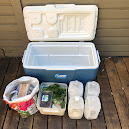Boy,
you’re gonna carry that weight,
Carry that
weight a long time . . ..*
The summer
between my senior year and freshman year in college, I learned to drink beer.
All of a sudden, I was up to 150. I was satisfied with a 150-pound body and I
was able to maintain that weight through four years of college.
I may have
put on a few pounds during the years of my first job but made a concerted
effort to lose them before my wedding day. I was a svelte 148 when I married
the love of my life at age 24. Of course, that didn’t last long as my new wife
was an excellent cook. I crept up toward 158 but found that I was able to shed
five pounds almost at will.
I was 30
years old when my wife became pregnant with our first child. We had two more
children over the next six and a half years. When my wife was gaining her
pregnancy weight, I was putting on sympathy pounds. By the time our third child
was born, I had become a man of substance, weighing in at about 162 pounds.
My chosen career was a lawyer, meaning that the bulk of my time was spent sitting behind a desk in an office. Still, I intentionally parked my car about a mile from my office, so I had a nice morning and afternoon walk. If the weather was pleasant, I would stroll around town during lunch hour. On several occasions, I rode the bus to work and then walked the three miles from my office to home. All that walking helped me to maintain my weight around 165, give or take a few pounds.
I retired after 30 years as a lawyer and somehow I was able to stay in that same range for the next eight years. Then came 2020 and the COVID pandemic. Between the idleness, the stress and, admittedly, the beer, I gained 15 pounds. I’ve carried that weight ever since.
 Since the
end of the pandemic, I have made several efforts to lose my pandemic paunch. My
Medicare Advantage plan offers a free gym membership, so I joined LA Fitness. I
signed up for a personal trainer and did weekly workouts with him for five
months. Between those sessions, I walked around town or used the treadmill at the
gym, striving to get 10,000 steps a day. Despite those efforts, my weight
stayed the same or maybe increased a pound or two.
Since the
end of the pandemic, I have made several efforts to lose my pandemic paunch. My
Medicare Advantage plan offers a free gym membership, so I joined LA Fitness. I
signed up for a personal trainer and did weekly workouts with him for five
months. Between those sessions, I walked around town or used the treadmill at the
gym, striving to get 10,000 steps a day. Despite those efforts, my weight
stayed the same or maybe increased a pound or two.
Recently,
I’ve begun a program of walking every day, watching my carbs, and lowering (but not eliminating) my
alcohol intake to wine with dinner and one beer in the evening. I find that if
I work really hard at this program, I can shed a pound or two over a week and a
half. Unfortunately, one day of indulging myself with a second beer and a small
bag of potato chips will put those pounds right back on.
Perhaps that is the scourge of old age that carries with it diabetes, high blood pressure, high cholesterol, and sleep apnea along with weight that comes easily and doesn’t want to go away. And if I’m “gonna carry that weight a long time,” I am content, given the alternative, to still be healthy enough to walk, play board games with my wife, and strum my guitar.
*Carry
that Weight, John Lennon & Paul McCartney, Abbey Road LP (1969)


.png)












